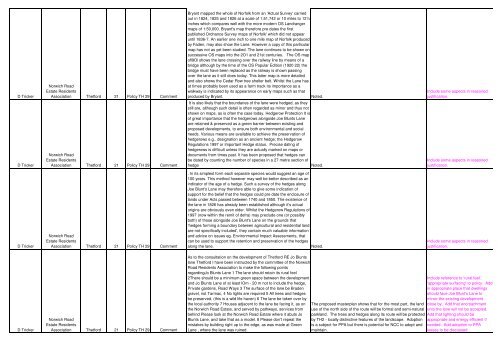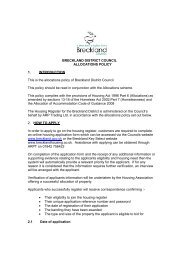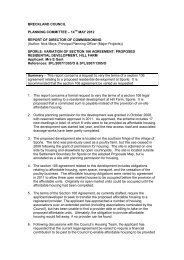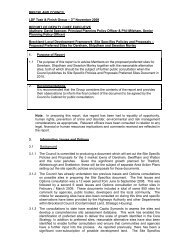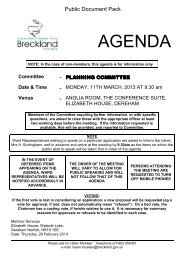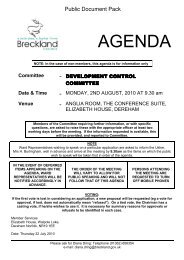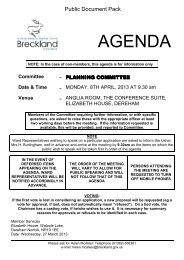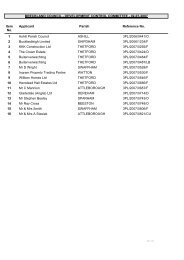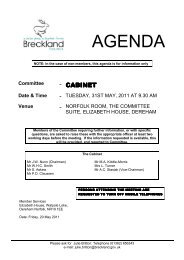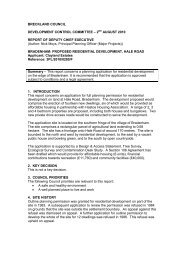NOT TO BE PRINTED_Draft Final TAAP comments duly
NOT TO BE PRINTED_Draft Final TAAP comments duly
NOT TO BE PRINTED_Draft Final TAAP comments duly
Create successful ePaper yourself
Turn your PDF publications into a flip-book with our unique Google optimized e-Paper software.
D Tricker<br />
D Tricker<br />
D Tricker<br />
D Tricker<br />
Norwich Road<br />
Estate Residents<br />
Association Thetford 21 Policy TH 29 Comment<br />
Norwich Road<br />
Estate Residents<br />
Association Thetford 21 Policy TH 29 Comment<br />
Norwich Road<br />
Estate Residents<br />
Association Thetford 21 Policy TH 29 Comment<br />
Norwich Road<br />
Estate Residents<br />
Association Thetford 21 Policy TH 29 Comment<br />
Bryant mapped the whole of Norfolk from an ‘Actual Survey' carried<br />
out in 1824, 1825 and 1826 at a scale of 1:51,742 or 10 miles to 12¼<br />
inches which compares well with the more modern OS Landranger<br />
maps of 1:50,000. Bryant's map therefore pre dates the first<br />
published Ordnance Survey maps of Norfolk' which did not appear<br />
until 1836-7. An earlier one inch to one mile map of Norfolk produced<br />
by Faden, may also show the Lane. However a copy of this particular<br />
map has not as yet been studied. The lane continues to be shown on<br />
successive OS maps into the 2O1 and 21st centuries. The OS map<br />
ofl9Ol shows the lane crossing over the railway line by means of a<br />
bridge although by the time of the OS Popular Edition (1920 22) the<br />
bridge must have been replaced as the railway is shown passing<br />
over the lane as it still does today. This latter map is more detailed<br />
and also shows the Cedar Row tree shelter belt. Whilst the Lane has<br />
at times probably been used as a farm track its importance as a<br />
walkway is indicated by its appearance on early maps such as that<br />
produced by Bryant. Noted.<br />
It is also likely that the boundaries of the lane were hedged, as they<br />
still are, although such detail is often regarded as minor and thus not<br />
shown on maps, as is often the case today. Hedgerow Protection It is<br />
of great importance that the hedgerows alongside Joe Blunts Lane<br />
are retained & preserved as a green barrier between existing and<br />
proposed developments, to ensure both environmental and social<br />
needs. Various means are available to achieve the preservation of<br />
hedgerows e.g.. designation as an ancient hedge; the Hedgerow<br />
Regulations 1997 or Important Hedge status. Precise dating of<br />
hedgerows is difficult unless they are actually marked on maps or<br />
documents from times past. It has been proposed that hedges can<br />
be dated by counting the number of species in a 27 metre section of<br />
hedge Noted.<br />
. In its simplest form each separate species would suggest an age of<br />
100 years. This method however may well be better described as an<br />
indicator of the age of a hedge. Such a survey of the hedges along<br />
Joe Blunt's Lane may therefore able to give some indication of<br />
support for the belief that the hedges could pre date the enclosure of<br />
lands under Acts passed between 1740 and 1850. The existence of<br />
the lane in 1826 has already been established although it's actual<br />
origins are obviously even older. Whilst the Hedgerow Regulations of<br />
1997 (now within the remit of defra) may preclude one (or possibly<br />
both) of those alongside Joe Blunt's Lane on the grounds that<br />
‘hedges forming a boundary between agricultural and residential land<br />
are not specifically included', they contain much valuable information<br />
and advice on issues eg. Environmental Impact Assessments, that<br />
can be used to support the retention and preservation of the hedges<br />
along the lane. Noted.<br />
As to the consultation on the development of Thetford RE Jo Blunts<br />
lane Thetford I have been instructed by the committee of the Norwich<br />
Road Residents Association to make the following points<br />
regardingJo Blunts Lane 1 The lane should retain its rural feel<br />
2There should be a minimum green space between the development<br />
and Jo Blunts Lane of at least lOm - 20 m not to include the hedge,<br />
Private gardens, Road Ways 3 The surface of the lane be Braden<br />
gravel, not Tarmac, 4 No lights are required 5 All trees and hedges<br />
be preserved, (this is a wild life haven) 6 The lane be taken over by<br />
the local authority 7 Houses adjacent to the lane be facing it, as on<br />
the Norwich Road Estate, and served by pathways, services from<br />
behind Please look at the Norwich Road Estate where it abuts Jo<br />
Blunts Lane, and take that as a model. 8 Please don't repeat the<br />
mistakes by building right up to the edge, as was made at Green<br />
Lane , where the lane was ruined.<br />
The proposed masterplan shows that for the most part, the land<br />
use of the north side of the route will be formal and semi-natural<br />
parkland. The trees and hedges along its route will be protected<br />
by TH2 - locally distinctive features of the landscape. Adoption<br />
is a subject for PPA but there is potential for NCC to adopt and<br />
maintain.<br />
Include some aspects in reasoned<br />
justification.<br />
Include some aspects in reasoned<br />
justification.<br />
Include some aspects in reasoned<br />
justification.<br />
Include reference to 'rural feel',<br />
'appropriate surfacing' to policy. Add<br />
in appropriate place that dwellings<br />
should face Joe Blunt's Lane to<br />
mirror the existing development<br />
close by, Add that encroachment<br />
onto the lane will not be accepted.<br />
Add that lighting should be<br />
appropriate and energy efficient if<br />
needed. Add adoption to PPA<br />
issues to be discussed.


